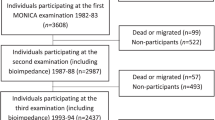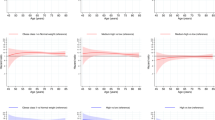Abstract
OBJECTIVES: To assess the relationship of body weight and anthropometry to all-cause mortality in older men.
DESIGN: A prospective cohort study of 3741 elderly Japanese-American men, enrolled in the Honolulu Heart Program. For this report, the follow-up began at baseline examinations (1991–1993), when the men were aged 71–93 y.
MEASUREMENTS: Variables of interest were body mass index (BMI), waist-to-hip ratio (WHR), and the sum of the subscapular and triceps skinfold thickness. Possible confounders included age, education, physical activity index, smoking, alcohol consumption, systolic and diastolic blood pressure, cholesterol, glucose and insulin concentrations.
RESULTS: After an average of 4.5 y of follow-up, 766 men (21%) had died. Higher BMI was associated with lower adjusted mortality risks (relative risk (RR)) highest vs lowest quintile-based category=0.5, 95% confidence interval (CI): 0.4–0.6, P-trend<0.001). Results were independent of WHR, and did not change after excluding current and former smokers or those who died within one year of follow-up. The relation between WHR and mortality appeared to be U-shaped, but after adjustment for BMI, a higher WHR steadily increased the risk of dying (RR highest vs lowest category=1.5, 95%CI: 1.1–2.0, P-trend=0.004). Especially in subjects with a high BMI, there was a positive association between WHR and mortality. The results for skinfold thickness were similar to the results for BMI, but less strong.
CONCLUSIONS: In older men, BMI and skinfold thickness showed a consistent inverse association with mortality, even after accounting for early mortality. The WHR, on the other hand, was positively related to mortality, especially when BMI was high. Thus, excess abdominal fat mass (FM) warrants closer concern than being overweight, in terms of affecting mortality in the elderly.
This is a preview of subscription content, access via your institution
Access options
Subscribe to this journal
Receive 12 print issues and online access
$259.00 per year
only $21.58 per issue
Buy this article
- Purchase on SpringerLink
- Instant access to full article PDF
Prices may be subject to local taxes which are calculated during checkout
Similar content being viewed by others
Author information
Authors and Affiliations
Rights and permissions
About this article
Cite this article
Kalmijn, S., Curb, J., Rodriguez, B. et al. The association of body weight and anthropometry with mortality in elderly men: The Honolulu Heart Program. Int J Obes 23, 395–402 (1999). https://doi.org/10.1038/sj.ijo.0800832
Received:
Revised:
Accepted:
Published:
Issue Date:
DOI: https://doi.org/10.1038/sj.ijo.0800832
Keywords
This article is cited by
-
Relationship between body mass and ambulatory blood pressure: comparison with office blood pressure measurement and effect of treatment
Journal of Human Hypertension (2018)
-
The effect of age on the shape of the BMI–mortality relation and BMI associated with minimum all-cause mortality in a large Austrian cohort
International Journal of Obesity (2015)
-
The dynamic association of body mass index and all-cause mortality in multiple cohorts and its impacts
Emerging Themes in Epidemiology (2014)
-
Is obesity a marker of robustness in vulnerable hospitalized aged populations? Prospective, multicenter cohort study of 1 306 acutely ill patients
The Journal of nutrition, health and aging (2014)
-
Gastric Bypass for Obesity in the Elderly: Is It as Appropriate as for Young and Middle-Aged Populations?
Obesity Surgery (2014)



